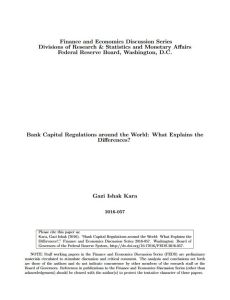Join getAbstract to access the summary!

Join getAbstract to access the summary!
Gazi Ishak Kara
Bank Capital Regulations around the World
What Explains the Differences?
Federal Reserve Board, 2016
What's inside?
Bank capital adequacy standards vary in their applications across countries and over time.
Recommendation
Long the global standard for bank capital adequacy management, the Basel protocols on bank capital buffers are well-intended yet complex. That complexity leads to a broad interpretation and application of its rules, as economist Gazi Ishak Kara notes in his scholarly analysis. The macroeconomic conditions of individual countries often bear on how strictly they implement the capital reserve rules. getAbstract recommends Kara’s report – written more for the economist and central banker – for its rigor and focus on an all-important domain in bank regulation.
Summary
About the Author
Gazi Isak Kara is a senior economist at the Board of Governors of the Federal Reserve System.

















Comment on this summary